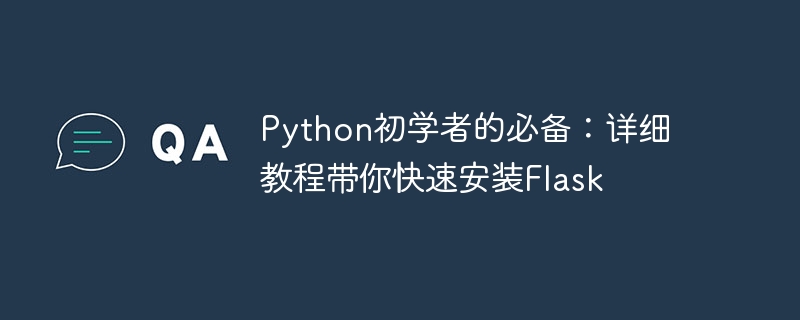

Must-have for Python beginners: Detailed tutorial to help you quickly install Flask
Flask is a simple, lightweight Python web framework that is widely used For developing web applications and APIs. For beginners, installing Flask is a necessary step to learn Python web development. This article will provide detailed tutorials and specific code examples to help you quickly install Flask and get it running.
Step 1: Install Python
First, we need to install Python on your computer. Flask is a Python-based framework, so Python installation is essential. You can download the latest Python version from Python's official website (https://www.python.org/) and install it according to the installation guide.
Step 2: Install a virtual environment
Before installing Flask, we strongly recommend that you use a virtual environment to isolate the dependencies of different projects. The virtual environment can ensure that each project has its own independent Python environment and avoid dependency conflicts between different projects.
Execute the following command in the command line to install the virtual environment:
$ pip install virtualenv
Step 3: Create and activate the virtual environment
Create a new virtual environment, you can specify a Folder as the directory of the virtual environment:
$ virtualenv myenv
Activate the virtual environment:
$ source myenv/bin/activate
Step 4: Install Flask
Execute the following command in the activated virtual environment to install Flask:
$ pip install flask
Wait for the installation to complete and you will have successfully installed Flask.
Step 5: Create a simple Flask application
Now, let us create a simple Flask application and run it. Create a new folder and create a Python script file in the folder named app.py.
In app.py, add the following code:
from flask import Flask
app = Flask(__name__)
@app.route('/')
def hello():
return 'Hello, Flask!'The above code creates a Flask application and defines a routing functionhello , this function responds to the request of the root URL / and returns the string Hello, Flask!.
Step 6: Run the Flask application
Run the following command in the command line to start the Flask application:
$ python app.py
You will see some output similar to the following:
* Running on http://127.0.0.1:5000/ (Press CTRL+C to quit)
This means that the Flask application has successfully run on the local URL http://127.0.0.1:5000/. Open the URL with a browser and you will see Hello, Flask! displayed on the web page.
Congratulations! You have successfully installed and run a simple Flask application.
Summary:
In this article, we provide detailed tutorials and code examples to help Python beginners quickly install Flask. By installing, configuring a virtual environment, and running a simple Flask application, you can start exploring the world of developing web applications and APIs in Python using Flask. Flask is a simple, lightweight framework, but it provides powerful functionality and flexibility suitable for web development needs of all sizes. I hope this article will help you get started with Flask!
The above is the detailed content of Essential for getting started with Python: Detailed tutorial on Flask installation to help you get started quickly. For more information, please follow other related articles on the PHP Chinese website!